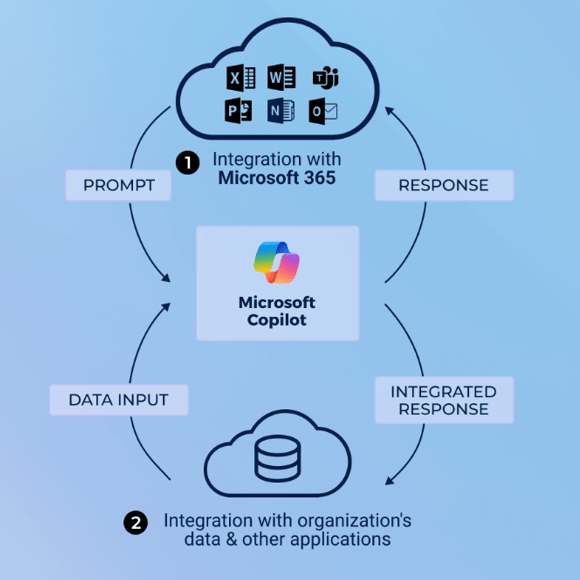Business
leaders are concerned about data access rights and whether their company data
will be exposed externally. As Copilot automatically adheres to organizations'
stringent security, compliance, and privacy protocols, it will ensure that
there will be no data breach if it is provided with the effective privacy
policy. Besides privacy concerns, business leaders want to make sure that
Copilot will be the right technology for them given their infrastructure
landscape, making use case identification very critical. They also want to
make sure that Copilot will be very well adopted by users, otherwise it will
be a huge waste of expense.
Our Advice
Critical Insight
Leverage the power of Microsoft 365 Copilot by strategically defining goals, identifying user groups, implementing robust data protection plans, and monitoring deployment progress through user feedback.
Impact and Result
- Understand Copilot capabilities, core components and working model.
- Identify Copilot use cases and review real-world examples for each use case.
- Review best practices to utilize Copilot’s capabilities.
- Extend Copilot’s capabilities to other platforms.
- Review key considerations to deploy Copilot.
- Monitor and track Copilot’s impact for further extension.
Member Testimonials
After each Info-Tech experience, we ask our members to quantify the real-time savings, monetary impact, and project improvements our research helped them achieve. See our top member experiences for this blueprint and what our clients have to say.
9.4/10
Overall Impact
$7,343
Average $ Saved
7
Average Days Saved
Client
Experience
Impact
$ Saved
Days Saved
City of Moreno Valley
Guided Implementation
10/10
$5,480
2
Great Lakes Water Authority
Guided Implementation
10/10
$13,700
9
No bad parts. Scott is awesome!
Carver County, MN
Guided Implementation
9/10
$1,096
2
State Universities Retirement System Of Illinois
Guided Implementation
10/10
N/A
20
Scott presented many things to consider when implement Copilot into our environment, particularly in the preparation and readiness aspects. There ... Read More
Blue Cross Blue Shield of North Dakota
Guided Implementation
10/10
N/A
5
Ability to discuss projects and our ideas and hear from an expert who has seen 100 of these implementations is very valuable. No negatives with ou... Read More
Lifespace Communities, Inc.
Guided Implementation
8/10
$4,110
4
Cidel Bank & Trust
Guided Implementation
9/10
$12,330
5
John was very helpful and knowledgeable in his advice on copilot, and was able to make suggestions and recommendations for how we can approach its ... Read More
The Salvation Army UK and Ireland
Guided Implementation
9/10
N/A
N/A
Mahmoud’s insights were of great value to help move us forward for testing of Microsoft’s Copilot. He is extremely knowledgeable and pointed us in ... Read More

 (Image Source: Microsoft)
(Image Source: Microsoft)
 Create a Service Management and IT Operations Strategy
Create a Service Management and IT Operations Strategy
 Optimize the IT Operations Center
Optimize the IT Operations Center
 Improve Incident and Problem Management
Improve Incident and Problem Management
 Optimize IT Change Management
Optimize IT Change Management
 Harness Configuration Management Superpowers
Harness Configuration Management Superpowers
 Develop Infrastructure & Operations Policies and Procedures
Develop Infrastructure & Operations Policies and Procedures
 Stabilize Release and Deployment Management
Stabilize Release and Deployment Management
 Deploy AIOps to Improve IT Operations
Deploy AIOps to Improve IT Operations
 Create Visual SOP Documents that Drive Process Optimization, Not Just Peace of Mind
Create Visual SOP Documents that Drive Process Optimization, Not Just Peace of Mind
 Improve IT-Business Alignment Through an Internal SLA
Improve IT-Business Alignment Through an Internal SLA
 Implement Infrastructure Shared Services
Implement Infrastructure Shared Services
 Next-Generation InfraOps
Next-Generation InfraOps
 M&A Runbook for Infrastructure and Operations
M&A Runbook for Infrastructure and Operations
 Reduce Manual Repetitive Work With IT Automation
Reduce Manual Repetitive Work With IT Automation
 Take Control of Cloud Costs on AWS
Take Control of Cloud Costs on AWS
 Take Control of Cloud Costs on Microsoft Azure
Take Control of Cloud Costs on Microsoft Azure
 Govern Shared Services
Govern Shared Services
 Responsibly Resume IT Operations in the Office
Responsibly Resume IT Operations in the Office
 Take Control of Infrastructure and Operations Metrics
Take Control of Infrastructure and Operations Metrics
 Engineer Your Event Management Process
Engineer Your Event Management Process
 Design Your Cloud Operations
Design Your Cloud Operations
 Build a Continual Improvement Program
Build a Continual Improvement Program
 Align Projects With the IT Change Lifecycle
Align Projects With the IT Change Lifecycle
 Prepare for Microsoft 365 Copilot
Prepare for Microsoft 365 Copilot
 Build Seamless IT Operations With Automation
Build Seamless IT Operations With Automation







